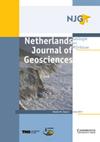荷兰城市化沿海三角洲平原的差异沉降
IF 2.3
2区 地球科学
Q3 GEOSCIENCES, MULTIDISCIPLINARY
Netherlands Journal of Geosciences-Geologie En Mijnbouw
Pub Date : 2018-10-09
DOI:10.1017/njg.2018.11
引用次数: 26
摘要
由于人类活动导致地下水位下降,荷兰富含泥炭的沿海三角洲平原正在严重下沉,因为这导致泥炭层压缩和氧化。为了确定该地区对未来泥炭压缩和氧化沉降的潜在敏感性,使用沉降模型定量评估了降低当前潜水地下水水位的影响。输入是一个三维地质地下体素模型,模拟的潜水地下水位,以及泥炭压缩和氧化功能。潜水地下水位降低0.25米和0.5米,并确定了15年和30年期间泥炭压缩和氧化的结果。示范区包括主要城市阿姆斯特丹和鹿特丹及其周围的农业用地。结果表明,在这些情景下,农业区可能会下沉0.3 ~ 0.8m;阿姆斯特丹和鹿特丹的潜在下陷要低得多,不到0.4米。这是由于城市下面的泥炭上覆盖着几米厚的人为土壤,这些土壤已经将泥炭压缩到地下水位以下的深度,从而最大限度地减少了进一步的压缩和氧化。在农业地区,泥炭通常位于地表附近,因此具有高度可压缩性,易于氧化。这些情景的平均沉降率范围在7至13mma−1之间,这与荷兰泥炭地区目前的沉降率相对应。这些结果与其他三角洲的沿海三角洲沉降趋势形成对比,城市沉降速度快于农业区。这种差异可以用下沉的驱动因素来解释:在其他三角洲,城市地区的下沉主要是由于深层含水层的开采,而在荷兰,下沉是由于潜水地下水位的降低。本文章由计算机程序翻译,如有差异,请以英文原文为准。
Differential subsidence in the urbanised coastal-deltaic plain of the Netherlands
Abstract The urbanised peat-rich coastal-deltaic plain of the Netherlands is severely subsiding due to human-induced phreatic groundwater level lowering, as this causes peat layers to compress and oxidise. To determine the potential susceptibility of this area to future subsidence by peat compression and oxidation, the effects of lowering present-day phreatic groundwater levels were quantitatively evaluated using a subsidence model. Input were a 3D geological subsurface voxel-model, modelled phreatic groundwater levels, and functions for peat compression and oxidation. Phreatic groundwater levels were lowered by 0.25 and 0.5m, and the resulting peat compression and oxidation over periods of 15 and 30 years were determined. The model area comprised the major cities Amsterdam and Rotterdam, and their surrounding agricultural lands. The results revealed that for these scenarios agricultural areas may subside between 0.3 and 0.8m; potential subsidence in Amsterdam and Rotterdam is considerably lower, less than 0.4m. This is due to the presence of several metres thick anthropogenic brought-up soils overlying the peat below the urban areas, which has already compressed the peat to a depth below groundwater level, and thus minimises further compression and oxidation. In agricultural areas peat is often situated near the surface, and is therefore highly compressible and prone to oxidation. The averaged subsidence rates for the scenarios range between 7 and 13mma−1, which is corresponds to present-day rates of subsidence in the peat areas of the Netherlands. These results contrast with the trend of coastal-deltaic subsidence in other deltas, with cities subsiding faster than agricultural areas. This difference is explained by the driver of subsidence: in other deltas, subsidence of urban areas is mainly due to deep aquifer extraction, whereas in the Netherlands subsidence is due to phreatic groundwater level lowering.
求助全文
通过发布文献求助,成功后即可免费获取论文全文。
去求助
来源期刊
CiteScore
4.00
自引率
25.90%
发文量
14
审稿时长
>12 weeks
期刊介绍:
Netherlands Journal of Geosciences - Geologie en Mijnbouw is a fully open access journal which publishes papers on all aspects of geoscience, providing they are of international interest and quality. As the official publication of the ''Netherlands Journal of Geosciences'' Foundation the journal publishes new and significant research in geosciences with a regional focus on the Netherlands, the North Sea region and relevant adjacent areas. A wide range of topics within the geosciences are covered in the journal, including "geology, physical geography, geophyics, (geo-)archeology, paleontology, hydro(geo)logy, hydrocarbon exploration, modelling and visualisation."
The journal is a continuation of Geologie and Mijnbouw (published by the Royal Geological and Mining Society of the Netherlands, KNGMG) and Mededelingen Nederlands Instituut voor Toegepaste Geowetenschappen (published by TNO Geological Survey of the Netherlands). The journal is published in full colour.

 求助内容:
求助内容: 应助结果提醒方式:
应助结果提醒方式:


